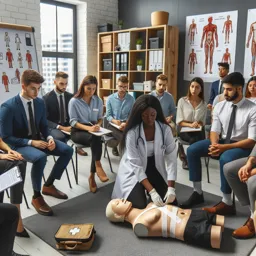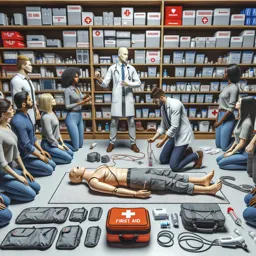While it is evident that knowledge of first aid is important, capable of being decisive in saving lives, some only remember it in critical and terrified moments, when they usually also realize that they have learned very little, or not learned about first aid. .
Basic first aid knowledge
It is not incumbent upon a large part of the population to have this knowledge, however, knowing the basics of first aid is a very significant benefit.
The Heimlich Maneuver takes its name because it was described in 1974 by the American physician Henry Heimlich. This maneuver is considered to be an indicated conduct in first aid for choking. The procedure artificially stimulates coughing by causing an increase in intrathoracic pressure and elevation of the diaphragm, which as a consequence is expected to expel the foreign body causing the airway obstruction.
In Heimlich’s own words: “Standing behind the victim, the rescuer places both arms around the choker just above the waistline, allowing the head, arms, and upper torso to hang forward. Then, holding the right wrist with the left hand, the rescuer presses quickly and strongly on the victim’s abdomen, forcing the diaphragm up, compressing the lungs and expelling the obstructive bolus.”
The Brazilian otolaryngologist Eduardo de Sá Pedroso explains about the Heimlich Maneuver in babies.
“In these cases, if it is a baby, it is necessary to place it on its stomach, supported on the arm and, in turn, on the leg. If it’s liquid, this position already helps. If it was an obstruction by a solid, it is necessary to push the back, with a force dosed for the size of the child”.
Eduardo de Sá warns that one cannot forget to ask someone to call for professional help.
Regarding cardiorespiratory arrest, Brazilian doctor Hélio Penna, a specialist in emergency medicine, says that the chances of survival are four times greater when someone fit recognizes the symptoms, asks for help from the appropriate emergency service, and above all, starts chest compressions.
Chest compressions are also called cardiac massages and are part of the cardiopulmonary resuscitation procedure.
“It is essential that the population recognize, call for help and know how to act. Don’t wait for the doctor or any health professional”, understands Brazilian cardiologist Sergio Timerman.
Agnaldo Piscopo, also a Brazilian cardiologist, explains the procedure.
“First of all, the person should be placed on their back on a hard surface and should never be tried to give them water. Then, the orientation is to check if the victim is awake and if there is breathing movement. If not, for both checks, it is a stop. From that point on, it is necessary to call the emergency services, and, while specialized help does not arrive, start the massages. Chest compressions are done with one hand over the other and the arms extended. They should be applied on the line between the nipples. The chest needs to sink between five and six cm to have an effect. There are 100 to 120 movements per minute. As the procedure requires physical effort from the volunteer, the ideal is to have a relay to keep the massage constant until the patient wakes up or until help arrives.”
Know what not to do in first aid
For the Brazilian doctor Dráuzio Varella, it is not only important to know what to do, but also to know what not to do in first aid. For example, about the burn, there are those who say to put coffee and various substances in the affected region, which is wrong. The correct measure is to open the faucet and use running water at room temperature on the affected region for about five minutes. In wounds with cuts, it is not recommended to apply alcohol. The recommended procedure is to clean the cut area with soap and water. If there is bleeding, compress with a clean cloth and wait for stabilization.
Dráuzio Varella also says that it is necessary to seek specialized support in more serious cases of burns and cuts.
Knowing first aid is a demand in certain professional activities
If knowledge of first aid is important for society in general, in certain professions it is a demand or requirement.
In professional activities related to medicine, such as nursing and dentistry, the need is evident. However, other professional activities also treat first aid as a demand or requirement. This is the case of physical educator, personal trainer, physical trainer and sports coach activities.
Among other professions, knowledge is also generally required for teachers who teach in group classes, crews and other professionals who work with the public, including caregivers, clerks, salespeople, janitors and trustees.
Prevention of risks and accidents
Sad to see, however, the human being is susceptible to countless misfortunes.
Hemorrhagic stroke, ischemic stroke, choking, convulsion, fainting, heart attack, burn, fracture, poisoning, electric shock and venomous animal bite are some of these misfortunes.
Therefore, prevention is a measure that must be constant. For example, be careful when chewing, avoid risk of falling and do not store dangerous substances in juice packs, or any packaging that could cause confusion with the product originally packaged.
Avoiding addiction and chemical dependency, such as smoking, having a healthy diet and practicing physical activities regularly are some measures that help a lot to prevent several of the reasons that cause the need for first aid.
Free first aid courses
There are several options for free courses for those who hope to acquire at least basic knowledge of first aid. Online courses and video courses are among the options.
The internet offers good alternatives to acquire this knowledge, however, many postpone or reject the opportunity of learning to use their time on the internet only with distractions or entertainment.
In addition, firefighters generally also respond to requests from condominiums, schools and various institutions to schedule educational lectures on the subject of first aid.
Call for the support of first responders
Knowledge in first aid and prudence are essential for the decision to act in cases that cannot be expected, or wait for specialists. For example, while the
need for relief and cardiopulmonary resuscitation actions cannot wait for professional care, in certain emergencies, it is recommended to wait.
For example, in car accidents, according to Brazilian firefighter José Heron Goulart, the victim should not be removed by a lay person unless there is a risk of explosion.
Chilean physician Carlos Rivera Prat says that in case of blood loss, severe bleeding can be fatal, and direct compression is the best way to treat it. You can use your hand, a bandage, gauze or any available material capable of fulfilling the objective.
Spanish doctor José Ramón Aguilar Reguero, a specialist in emergency medicine, says that there can be a fracture of a cervical vertebra without spinal cord injury. Spinal cord damage, with risks of fatal consequences, can be caused by movement, rotation or rotation of the injured person’s neck. Aguilar suggests not moving the victim and stabilizing their neck carefully.
The Brazilian pediatrician Ana Escobar warns that accident victims with severe fractures, if moved, this fracture can become exposed. When the fracture is in the femur, for example, the bone fragment can damage the artery.
According to Brazilian pathologist Paulo Saldiva, if there is a fracture in the rib, a simple movement can make the bone perforate the lung and cause internal bleeding.
As much as we know about first aid, it is necessary to have prudence about how to act in an emergency. One should not want to substitute specialized emergency care, make uncertain or hasty risk procedures.
The support of first responders or firefighters should be requested immediately when this need is noticed.
It is worth remembering that there are those who prefer to film the victim instead of providing help. Calling emergency medical attention is a decisive support in the provision of help. While some people use their cell phones to film the agony of others and maybe take advantage of it in some way, fortunately there are those who use the phone to call emergency medical care.


























